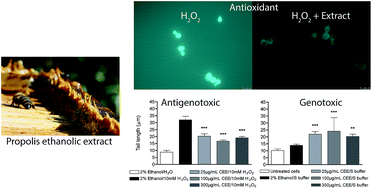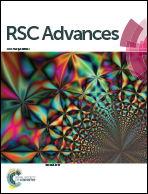Antioxidant and dual dose-dependent antigenotoxic and genotoxic properties of an ethanol extract of propolis†
Abstract
Propolis is a resinous product made by honeybees from plant-derived materials, with high content of polyphenols associated to several beneficial bioactivities with potential use as a natural food additive for preservation and as a functional food ingredient. A Portuguese propolis ethanol extract (C.EE) protected Saccharomyces cerevisiae cells from loss of viability upon exposure to H2O2, both in co- and in pre-incubation experiments. Results obtained with the comet assay suggest that lower concentrations are antigenotoxic while at higher concentrations a genotoxic effect prevails, which correlates with the cytotoxicity of high concentrations of C.EE. Flow cytometry analysis with dichlorofluorescein indicates that C.EE induced intracellular antioxidant activity in vivo. Overall the results suggest that C.EE is antigenotoxic but is also toxic at higher concentrations. This dual effect could be explained by the presence of compounds known to interfere with DNA synthesis and/or cell proliferation, such as caffeic acid phenethyl ester (CAPE) and chrysin, together with antioxidants, like kaempferol, pinobanksin and pinocembrin.



 Please wait while we load your content...
Please wait while we load your content...